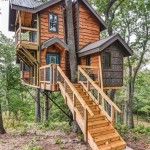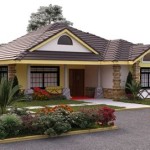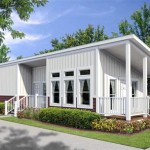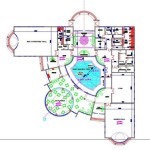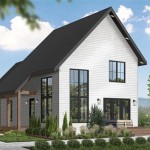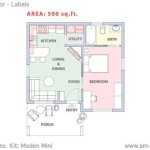Modern House Plan With Drive Under Garage: Optimizing Space and Style
The modern house plan is continually evolving, driven by trends towards efficiency, aesthetics, and adaptability. Among these evolving designs, the house plan with a drive-under garage presents a compelling solution for homeowners seeking to maximize space utilization, particularly on sloping or challenging terrains. This architectural approach integrates the garage seamlessly into the foundation of the home, often at a lower level, allowing for a cohesive design that minimizes the visual impact of vehicle storage while maximizing living areas above. This article explores the fundamental aspects of the modern house plan with a drive-under garage, highlighting its benefits, design considerations, and suitability for various lifestyles.
Drive-under garages, also known as tuck-under garages or basement garages, are characterized by having the garage entrance accessible directly from the driveway, typically beneath a portion of the main living area. This design is especially advantageous when building on properties with significant slopes, as it allows the structure to integrate naturally with the land. Instead of requiring extensive excavation and retaining walls to create a level building pad, the drive-under garage utilizes the existing topography, potentially reducing construction costs and minimizing environmental impact.
The increasing demand for this type of house plan stems from the need to address common challenges in modern living, such as limited lot sizes in urban areas, growing concerns about efficient space management, and the desire to integrate sustainable building practices. Modern designs often incorporate features that enhance the livability and practicality of the home, such as mudrooms connecting the garage to the interior, flex spaces that can serve as home offices or recreation areas, and energy-efficient building materials and systems.
Maximizing Space and Functionality
The primary advantage of a modern house plan with a drive-under garage lies in its ability to maximize space utilization. On smaller lots, where surface area is at a premium, incorporating the garage into the building's foundation frees up valuable space for landscaping, outdoor living areas, or a larger footprint for the main house. Furthermore, on sloping lots, the drive-under garage eliminates the need for a separate detached garage, which can often disrupt the natural flow of the landscape and create additional challenges for accessibility.
Beyond spatial efficiency, the drive-under garage offers functional benefits. It provides direct access to the home, often through an interior staircase, making it convenient to transport groceries, luggage, or other items, particularly during inclement weather. This direct access also enhances security, as the garage serves as a secure entry point into the house. Furthermore, the space above the garage can be utilized in various ways, such as extending the living area, creating a dedicated home office, or adding bedrooms. The overall flexibility in design options allows homeowners to tailor the living space to their specific needs and preferences.
Modern designs often integrate the garage seamlessly into the overall aesthetic of the home. This can be achieved through features such as strategically placed windows for natural light, insulated garage doors that match the exterior cladding, and well-designed entryways that blend with the surrounding landscape. In addition, incorporating sustainable building practices, such as using recycled materials or installing solar panels on the roof, can further enhance the functionality and appeal of the house.
However, it's crucial to consider accessibility when planning a drive-under garage. Thoughtful design choices should be implemented to accommodate individuals with mobility challenges. Ramps, elevators, and appropriately graded walkways should be considered to ensure safe and convenient access to the home from the garage and driveway.
Design Considerations and Architectural Styles
Designing a modern house plan with a drive-under garage requires careful consideration of several factors, including the site's topography, local building codes, and the homeowner's lifestyle. The slope of the lot will dictate the extent to which the garage is integrated into the foundation. Steep slopes may require more extensive excavation and retaining walls, while gentler slopes may allow for a more subtle integration. It's crucial to engage with a qualified architect or structural engineer to assess the site conditions and develop a plan that meets all applicable regulations and ensures the structural integrity of the building.
The architectural style of the house should also be considered when designing the drive-under garage. Modern designs often feature clean lines, minimalist aesthetics, and an emphasis on natural light. The garage can be integrated into this aesthetic through features such as a recessed garage door, a flat roof that blends with the main structure, and strategically placed windows that provide natural light without compromising privacy. Other architectural styles, such as craftsman or traditional, can also be adapted to incorporate a drive-under garage, but it's crucial to maintain a cohesive design that reflects the overall character of the home.
Ventilation and moisture control are also critical considerations in the design of a drive-under garage. Adequate ventilation is necessary to prevent the buildup of harmful fumes from vehicles and to control moisture levels, which can lead to mold and mildew growth. This can be achieved through the installation of exhaust fans, proper insulation, and the use of moisture-resistant building materials. In addition, drainage systems should be designed to effectively manage stormwater runoff and prevent water from entering the garage.
The size and layout of the garage should be carefully considered based on the homeowner's needs. A single-car garage may be sufficient for some homeowners, while others may require a larger garage to accommodate multiple vehicles, storage, or a workshop. The layout of the garage should be designed to maximize space utilization and provide convenient access to vehicles and other items.
Suitability and Lifestyle Integration
The modern house plan with a drive-under garage is particularly well-suited for individuals and families seeking to maximize space utilization, enhance accessibility, and integrate sustainable building practices into their homes. It is an excellent choice for properties with challenging terrains, such as sloping lots or waterfront properties, where traditional building methods may be more difficult or expensive. This design allows for innovative integration with the landscape, optimizing space while maintaining aesthetic appeal.
This type of house plan can cater to a variety of lifestyles. For those working from home, the additional space above the garage can be converted into a dedicated home office, providing a quiet and productive workspace. Families with children may appreciate the convenience of direct access to the home from the garage, particularly during inclement weather. Empty nesters may find the reduced footprint and increased accessibility of a drive-under garage ideal for aging in place.
Furthermore, a drive-under garage can be integrated into a smart home system, allowing for remote control of garage doors, lighting, and security features. This enhances convenience and security, providing homeowners with greater control over their living environment. In addition, the use of energy-efficient building materials and systems can reduce the environmental impact of the home and lower utility bills.
However, it's important to consider the potential drawbacks of a drive-under garage. Depending on the design, the garage may be more susceptible to flooding, particularly in areas with high water tables or heavy rainfall. Proper drainage systems and flood-proofing measures should be implemented to mitigate this risk. In addition, the garage may require more insulation to prevent heat loss or gain, particularly if it is located below the main living area. The cost of construction may also be higher than that of a traditional house plan, due to the additional excavation and structural engineering required.
Ultimately, the decision to build a modern house plan with a drive-under garage is a personal one that should be based on a careful assessment of the homeowner's needs, preferences, and budget. By working with a qualified architect or builder, homeowners can create a design that maximizes space utilization, enhances functionality, and integrates seamlessly with their lifestyle.

Drive Under House Plans With Basement Garage The Designers

Hillside House Plans With Garages Underneath Houseplans Blog Com

4 Bedroom Contemporary Drive Under Style House Plan 4742

Plan 69649am Northwest House With Drive Under Garage Sloping Lot Plans

Plan 62726dj Striking Modern House With Courtyard And Drive Under Garage Contemporary Plans Exterior

Plan 41305 Hillside Modern House With Drive Under Garage

Drive Under House Plans Small Modern Raised Hillside

Modern Duplex House Plan With Drive Under Garage

Modern Style House Plan 3 Beds 2 Baths 3629 Sq Ft 1066 43 Homeplans Com

Plan 78498 Modern Duplex With Drive Under Garage

